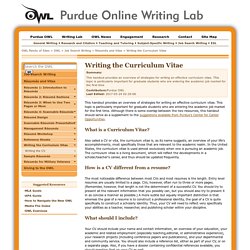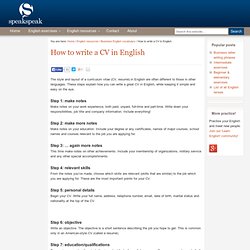

How to write a personal statement for your CV. Show an employer what you can bring to the table with a great CV profile.

Photograph: Pa A critical aspect of creating an effective CV is writing a personal statement, sometimes called a profile or career summary, that enables the recruiter to quickly identify the strategic value you can add to their organisation. Your CV should be a self-marketing document aimed at persuading the recruiter to interview you – and your personal statement is a critical part of making this happen. Many candidates struggle with writing the statement but it doesn't have to be a difficult as you may think. A well written statement can be between 50 and 200 words, although it is important not to ramble. It's important to read the job specification carefully and ensure not only that your skills and experience match but you reflect this in your statement. For example an opening statement without the opening "I" could read: As a general rule, it's best to break the statement into three sections: Writing the Curriculum Vitae. Summary: This handout provides an overview of strategies for writing an effective curriculum vitae.

This topic is particularly important for graduate students who are entering the academic job market for the first time Contributors:Purdue OWLLast Edited: 2017-03-24 02:29:06 This handout provides an overview of strategies for writing an effective curriculum vitae. This topic is particularly important for graduate students who are entering the academic job market for the first time. What is a Curriculum Vitae? Also called a CV or vita, the curriculum vitae is, as its name suggests, an overview of your life's accomplishments, most specifically those that are relevant to the academic realm. How to write a successful CV before applying for a job. 11 January 2015Last updated at 19:12 ET By Kevin Peachey Personal finance reporter, BBC News Kevin Peachey reports on the advice available for getting a potential employer's attention Employers receive an average of 60 applicants for every advertisement for a low-skilled job, and 20 for every skilled job.

Significantly, almost half of these candidates are perfectly suitable for the role, according to research by the Chartered Institute of Personnel and Development (CIPD) So that makes their CV - or curriculum vitae - all the more important when attempting to stand out from the crowd. Experts say there are some golden rules for getting a CV correct, not least accuracy, spelling and grammar.
Don't repeat the mistakes, they say, of a lawyer who stressed his "dew diligence", or the applicant who ignored commas when describing his interests as "cooking dogs and interesting people". Key points Applicants will often need to complete an application and send a CV Desperate measures Changing CVs. CV en inglés - Cómo redactar el mejor CV en inglés.
How to write a CV (resumé) in English. The style and layout of a curriculum vitae (CV, resumé) in English are often different to those in other languages.

These steps explain how you can write a great CV in English, while keeping it simple and easy on the eye. Step 1: make notes Make notes on your work experience, both paid, unpaid, full-time and part-time. Write down your responsibilities, job title and company information. Include everything! Step 2: make more notes Make notes on your education. Step 3: … again more notes This time make notes on other achievements. Step 4: relevant skills From the notes you’ve made, choose which skills are relevant (skills that are similar) to the job which you are applying for. Step 5: personal details Begin your CV. Step 6: objective Write an objective. Step 7: education/qualifications Summarize your education, including important facts (type of degree, specific courses you have studied) that are relevant to the job you are applying for. Writing a CV/résumé. Before beginning to draft your CV/résumé, read the advert carefully so that you are clear about the specific requirements of the job you’re applying for.

It’s important to tailor both your application letter and the CV/résumé to the job in question, focusing on qualifications and experience that are particularly relevant. Dos and Don’ts Here are some general points to bear in mind when preparing your CV/résumé: Do Don’t go into too much detail: employers are too busy to read rambling or unfocused CVs/résumés.leave gaps in your employment history: add a sentence or two explaining any periods that are not accounted for.use too many different fonts or typefaces: keep to one or two that are clear and easy to read.use inappropriate colours, graphics, or photos.name people as referees unless you’ve confirmed that they’re happy to provide a reference for you.
Structuring your CV/résumé Personal details Always begin with your personal details, i.e Employment history Educational qualifications Referees. Curriculum Vitae Format.